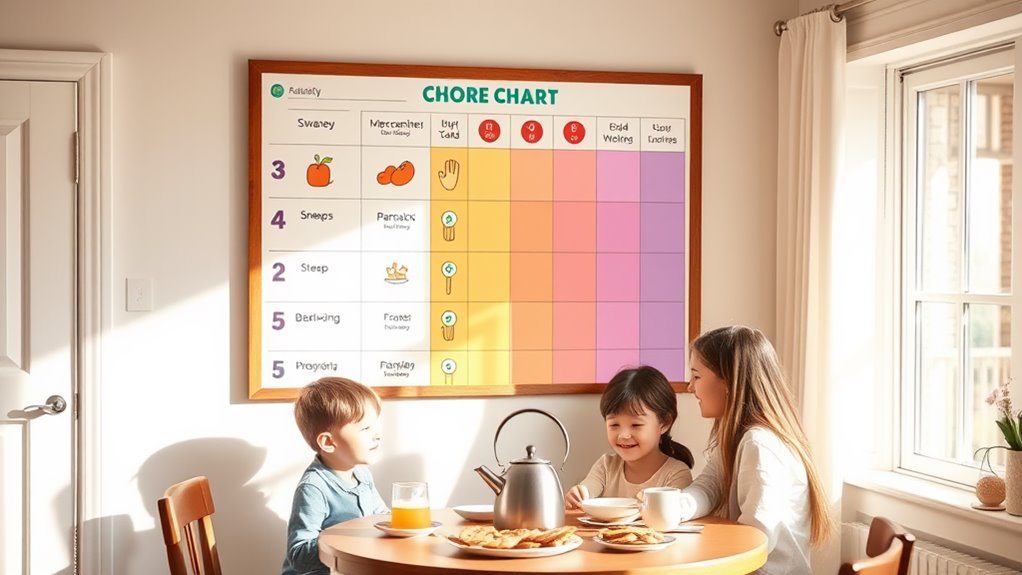Chore Schedules That Actually Work Say Goodbye to Chaos!
To say goodbye to chaos, start by creating a chore schedule that involves everyone in your household. Begin with an open dialogue to assess responsibilities and gather input for a balanced task distribution. Use a visual chore chart, with easy-to-read tasks and checkboxes, displayed in a common area. Be flexible; embrace spontaneity to adapt to changing needs and incorporate “wiggle room” in your plans. Establish accountability partners and hold regular check-ins to discuss progress. Celebrate milestones together to boost morale. You’ll discover more tips to enhance your family’s chore system as you explore further.
Key Takeaways
- Establish clear chore schedules to create routines that reduce confusion and foster responsibility in children while easing parental stress.
- Involve all family members in chore discussions to ensure balanced task distribution based on age, capability, and preferences.
- Use a visual chore chart that is easily accessible, clearly listing tasks with checkboxes for a sense of accomplishment.
- Hold regular check-ins to assess progress, address challenges, and adjust schedules as needed, ensuring everyone feels heard and valued.
- Celebrate small achievements and incorporate spontaneity to create a positive environment, making chores feel rewarding rather than burdensome.
Understanding the Need for Chore Schedules
Chore schedules are essential for maintaining an organized and harmonious home. By establishing a clear routine, you empower each family member to contribute effectively, enhancing overall family dynamics. When everyone knows what’s expected, it minimizes confusion and helps prevent resentment, leading to smoother interactions.
One of the key chore benefits is the development of responsibility in children. When they’re assigned specific tasks, they learn valuable life skills and the importance of teamwork. This not only fosters independence but also strengthens their connection to the family unit. As they see their efforts directly impact the household, a sense of pride and accomplishment emerges.
Moreover, chore schedules can considerably reduce stress for parents. Instead of constantly reminding family members about their duties, you can rely on a structured plan that everyone follows.
This predictability allows you to allocate time for other priorities, improving your overall quality of life.
Assessing Family Responsibilities
Before you create an effective chore schedule, it’s crucial to assess the responsibilities of each family member. Start by sitting down together and discussing each person’s daily routine and commitments. This open dialogue will help you understand your family dynamics better and identify how everyone contributes to household tasks.
Next, list all the chores that need attention, such as cleaning, cooking, grocery shopping, and laundry. Assign each chore a level of importance and frequency. This responsibility assessment should consider age, capability, and personal preferences, ensuring that tasks are fairly distributed.
It’s important to recognize that some family members may have more time or energy than others. For instance, kids may handle lighter chores, while adults take on more demanding tasks. Be flexible and willing to adjust responsibilities as needed, especially during busy periods or special events.
Finally, remember that the goal is to create a balanced system that promotes accountability without overwhelming anyone. By clearly understanding each family member’s responsibilities, you’re setting the foundation for a chore schedule that works harmoniously with your family’s unique dynamics.
Creating a Visual Chore Chart
Once you’ve assessed each family member’s responsibilities, it’s time to create a visual chore chart that everyone can easily understand and follow.
Start by selecting a chart design that suits your family’s needs—whether it’s a simple weekly grid or a more elaborate monthly layout.
Next, incorporate color coding to make the chart visually appealing and easily navigable. Assign a specific color to each family member, allowing them to quickly identify their tasks. This adds a layer of personalization and motivation, encouraging everyone to take ownership of their chores.
Be certain to list tasks clearly and specify the frequency—daily, weekly, or monthly. You might want to include checkboxes next to each chore for a satisfying sense of completion.
Once your chart is drafted, display it in a common area, like the kitchen or hallway, where everyone can see it regularly.
Regularly review and update the chart as responsibilities change. This not only keeps everyone engaged but also guarantees that the chart remains a functional tool rather than a static document.
With a well-structured visual chore chart, chaos can transform into harmony in your household.
Involving Everyone in the Process
To make chore schedules effective, it’s essential to involve everyone in the process.
Start by brainstorming together to guarantee everyone feels heard.
Then assign responsibilities fairly based on individual strengths.
Finally, establish accountability measures to keep everyone on track and motivated.
Brainstorming Together
While it’s easy to assume that chore assignments should be dictated by one person, involving everyone in the brainstorming process can lead to a more cooperative and effective chore schedule.
Start by gathering everyone to discuss their thoughts and preferences. This way, you’ll encourage creative brainstorming, allowing each individual to express their ideas.
During this session, focus on collaborative ideas. Ask open-ended questions to draw out opinions: Which chores do they enjoy? Which do they find challenging? This dialogue not only generates a variety of tasks but also promotes ownership and accountability. You might be surprised by the enthusiasm when everyone has a say.
Next, write down all suggestions without judgment. Once the ideas are laid out, categorize them based on frequency and difficulty. This structured approach will help visualize what needs to be done and allocate chores more effectively.
Finally, review the suggestions as a group, ensuring everyone feels heard. By involving all members in this brainstorming session, you’re more likely to create a chore schedule that everyone will adhere to, reducing chaos and fostering a sense of teamwork.
Assigning Responsibilities Fairly
A fair distribution of chores can make all the difference in maintaining harmony at home. To achieve this, start by evaluating everyone’s strengths and preferences. Create a list of all tasks that need to be done, ensuring you cover daily, weekly, and monthly chores.
Next, involve everyone in the process. Discuss the responsibilities openly and allow each person to express their preferences. This inclusion promotes a sense of ownership over the chores and enhances motivation. Aim for a fair division of tasks by balancing the workload—some may prefer quick, daily tasks, while others might be okay with more time-consuming chores.
Once you’ve identified equitable tasks, assign them based on individual capabilities and availability. Be flexible; if someone’s schedule changes, adjust the chore assignments accordingly. This adaptability helps maintain fairness and keeps everyone engaged.
Finally, revisit the chore schedule regularly. Gather feedback and make adjustments as necessary. By fostering open communication and ensuring everyone feels valued, you’ll create an environment where chores don’t lead to conflict but rather contribute to a well-functioning household.
Establishing Accountability Measures
Once you’ve assigned chores fairly, establishing accountability measures guarantees everyone follows through. Start by designating accountability partners. Pair up household members to encourage each other and share tips. This camaraderie fosters a sense of responsibility, making it less likely for anyone to drop the ball.
Next, implement a progress tracking system. Whether it’s a shared digital calendar, a physical chart on the fridge, or a chore app, visualizing progress helps everyone stay on track. Each partner should update their status regularly, creating transparency and motivating everyone to complete their tasks.
Consider holding weekly check-ins. These meetings can serve as a forum for discussing challenges, celebrating achievements, and recalibrating if necessary. Make sure everyone has a voice; this inclusion builds commitment and reinforces accountability.
Finally, recognize and reward consistent efforts. Acknowledge those who meet their commitments, whether through verbal praise or small incentives. This positive reinforcement cultivates a culture of responsibility and cooperation.
Establishing a Rotation System
Establishing a fair rotation system for chores can foster harmony and accountability within a household. By assigning chores on a rotating basis, you guarantee everyone shares the workload equitably. This method not only prevents resentment but also highlights the rotation benefits, as family members experience various tasks and develop new skills.
Start by listing all chores that need to be done regularly. Next, involve everyone in the discussion, allowing each person to express their preferences or concerns. From there, create a schedule that details who does what and when. Be certain to keep it visible, whether on a whiteboard or a shared digital calendar.
Consider implementing a weekly or bi-weekly rotation, which keeps things fresh and prevents monotony. If someone is unable to complete their assigned task, encourage them to swap with another family member in advance. This flexibility can enhance family harmony, as it fosters collaboration and communication.
Finally, review the system periodically. As family dynamics evolve, so too should your chore rotation. By maintaining an open dialogue, you guarantee that everyone remains engaged and accountable.
Tips for Staying Flexible
Staying flexible with your chore schedule is key to managing your household effectively.
Embrace spontaneity when it comes to tasks, as unexpected changes can arise.
Additionally, adjust your schedule based on current needs to guarantee everything runs smoothly.
Embrace Spontaneity Often
Life’s unpredictable nature often calls for a little flexibility in your chore schedule. Embracing spontaneity can’t only enhance your daily routine but also infuse your life with excitement and creativity.
To effectively incorporate spontaneous adventures, allow some wiggle room in your chore blocks. This way, if an impromptu opportunity arises, you can seize it without guilt.
Start by identifying non-essential tasks that can be postponed or completed later. You’ll find that some chores can wait, allowing you to explore those unplanned moments.
Next, prioritize your must-dos and allocate specific time slots for them. This structure provides a reliable foundation while still granting you the creative freedom to deviate when life calls.
Consider setting aside a “spontaneity hour” each week where you can either catch up on chores or immerse yourself in an unexpected activity. This proactive approach guarantees you’re not overwhelmed while still enjoying the benefits of spontaneity.
Ultimately, staying flexible in your chore schedule empowers you to balance responsibility and adventure, leading to a more fulfilling life. Remember, it’s all about finding that sweet spot between order and freedom.
Adjust According to Needs
Flexibility is key when it comes to managing your chore schedule. Life is unpredictable, and your approach should reflect that. By customizing schedules and adapting roles, you’ll find a balance that suits your household’s evolving needs.
Here are three practical tips to help you stay flexible:
- Regular Check-ins: Set aside time each week to discuss the current chore distribution. This lets everyone voice their concerns and suggests adjustments as needed.
- Prioritize Tasks: Identify which chores are non-negotiable and which can be shifted or delegated. This allows you to focus on what truly matters without feeling overwhelmed.
- Embrace Change: Don’t hesitate to modify your schedule if circumstances change—whether it’s a new job, a family commitment, or simply a change in energy levels.
Celebrating Achievements Together
Celebrating achievements together can transform mundane chore routines into rewarding experiences. When you take the time to recognize efforts and celebrate milestones, you create a positive environment that encourages greater participation and enthusiasm. Here’s a practical way to implement this:
| Activity | Milestone | Celebration Idea |
|---|---|---|
| Daily Chores | Completion of a week’s tasks | Family movie night |
| Weekly Clean-Up | Month of consistency | Potluck dinner |
| Monthly Organizing | Decluttering success | Outdoor picnic |
| Seasonal Deep Clean | Major milestone achieved | Game night with treats |
By consistently acknowledging each other’s contributions, you foster a sense of teamwork. Make it a habit to celebrate small wins. Whether it’s a simple high-five or a special treat, recognizing efforts keeps morale high and makes chores feel less intimidating.
As you implement these celebrations, you’ll notice that not only do tasks get done, but they also become an opportunity for connection. So go ahead, infuse celebration into your chore routine, and watch as your household transforms into a motivated team!
Frequently Asked Questions
How Do I Handle Resistance From Family Members About Chores?
Imagine a calm, organized home. To handle resistance, focus on family motivation strategies. Listen to concerns, involve everyone in decision-making, and celebrate small wins. Overcoming chore objections is easier when everyone feels valued and engaged.
What Tools Can I Use to Create a Chore Schedule?
To create a chore schedule, consider using a chore chart for visual tracking or digital apps for reminders and notifications. Both tools can simplify organization, making it easier for everyone to stay accountable and engaged.
How Often Should We Review and Adjust the Chore Schedule?
“Out of sight, out of mind” applies here. You should review your schedule frequency monthly, incorporating family input for adjustments. This keeps everyone engaged and guarantees the chores align with your household’s evolving needs.
Can Chore Schedules Work for Single-Parent Households?
Chore schedules can absolutely work for single-parent households. By implementing chore sharing and effective time management, you’ll streamline tasks, reduce stress, and create a more harmonious environment, allowing you to focus on quality time with your kids.
What Happens if Someone Consistently Neglects Their Chores?
If you consistently neglect your chores, imagine a pile of laundry growing like a mountain, suffocating your space. Accountability measures and consequences discussions become essential, ensuring you understand the impact of your choices on your environment.



